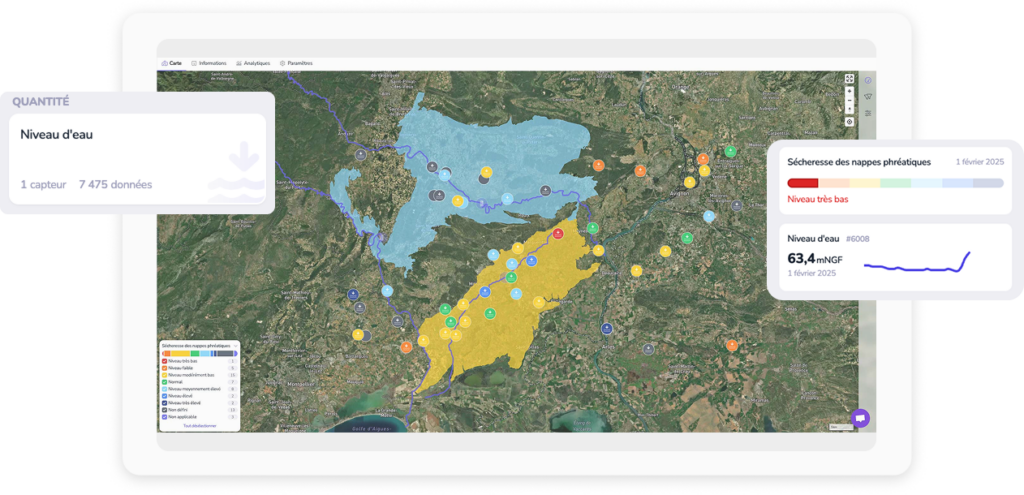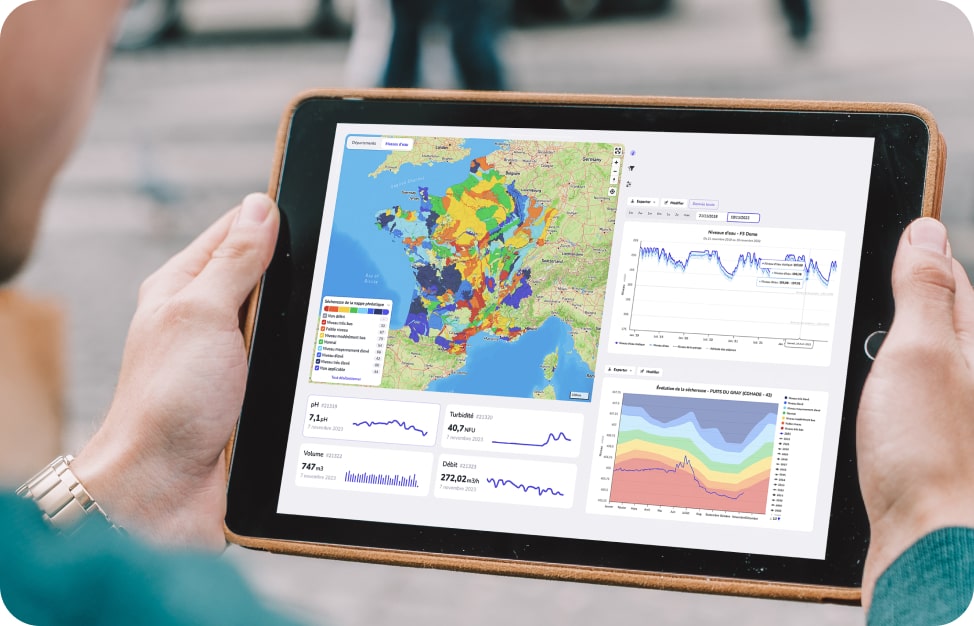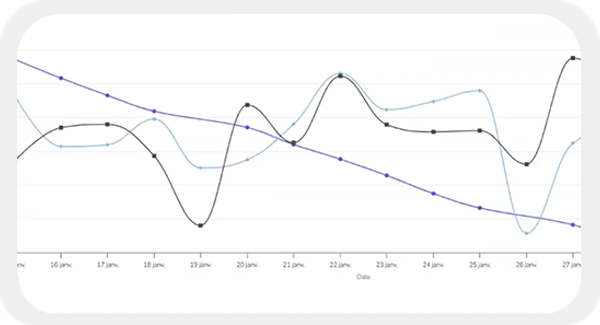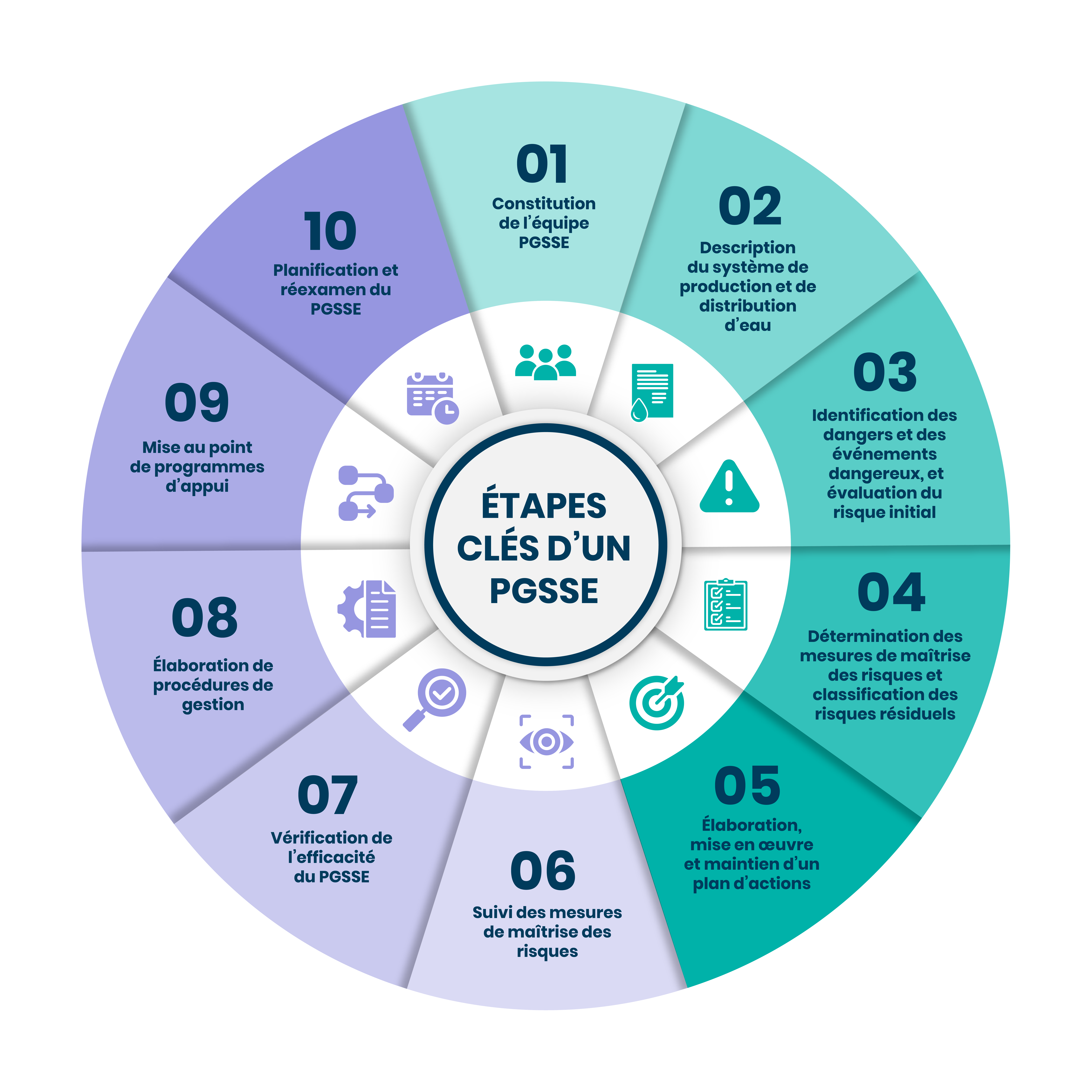
Contents
- Understanding, implementing and optimising your HSSMP approach
- What is a PGSSE?
- Why set up a SSMP?
- Anticipating risks and securing supply
- The key stages in drawing up a SSMP
- imaGeau’s EMI software: a lever for optimising implementation of the SSEMP
- EMI: securing water catchments and anticipating risks to strengthen your HSSMP approach
Understanding, implementing and optimising your HSSMP approach
Managing water safety is a priority for local authorities and industry. The Plan de Gestion de la Sécurité Sanitaire des Eaux (PGSSE – Water Safety Management Plan) helps to anticipate and prevent the risks associated with the distribution of drinking water. It is drawn up on the basis of a preventive approach and ongoing management of hazards that could affect water quality.
Faced with growing regulatory requirements and environmental challenges, digital tools are playing a key role in implementing and optimising WSSMPs. Integrating water resource management software enables local authorities and manufacturers to centralise data, monitor the state of resources in real time and anticipate risks.
Solutions such as those offered by imaGeau provide an innovative approach to improving control over water resources and ensuring regulatory compliance. Thanks to advanced analysis and modelling functions, this software enables proactive management, guaranteeing greater safety in the supply of drinking water.
What is a PGSSE?
Definition and objectives of the SSMP
The Water Safety Management Plan (PGSSE) is a comprehensive, preventive approach designed to ensure the ongoing safety of drinking water. It is based on a risk anticipation strategy, including an in-depth analysis of potential threats and the implementation of appropriate measures to prevent any deterioration in water quality.
In practical terms, the WSSMP encompasses a structured set of actions, including an in-depth study of hazards and the development of a detailed action plan covering all stages of the water cycle, from natural resources to final distribution. Its approach is based on dynamic, evolutionary management, enabling it to adapt to environmental changes, new regulations and technological advances.
Regulatory context and legal obligations
WSSMPs have been recommended by the World Health Organisation (WHO) since 2004, and have gradually been incorporated into national and European regulations. The aim is to adopt a preventive and comprehensive approach to drinking water management, rather than simply downstream control.
In Europe, the revised Drinking Water Directive (Directive 2020/2184) requires Member States to apply SWMPs across the board. In France, the deadlines for compliance are set at 2027 and 2029, depending on the size of the local authority:
By 2027: all local authorities supplying water to more than 50,000 people must have introduced an SSSMP.
By 2029: this obligation will be extended to local authorities serving more than 5,000 inhabitants.
These obligations require a structured approach to be put in place, including hazard identification, risk assessment and the implementation of corrective and preventive measures.
Who are the stakeholders involved in a SSEMP?
Implementing a WSSMP requires close collaboration between a number of players, each of whom has an essential role to play in guaranteeing the safety and quality of drinking water.
- Local authorities: responsible for drinking water management in their area, they must implement and monitor the SWMPs in accordance with legal obligations.
- Water operators and utilities: whether public services or private operators, these players are responsible for collecting, treating and distributing water.
- Water agencies and health authorities: they supervise and monitor the quality of the water supplied, ensuring compliance with health standards.
- Manufacturers and water resource managers: in sensitive sectors (agri-food, pharmaceuticals, etc.), these players must incorporate the principles of the SSMP into their water management.
- Citizens and users: although they are not directly involved in implementation, they are the primary beneficiaries of an effective SWMP and must be kept informed of the steps taken to guarantee water quality.
As you will have realised, the WSSMP is a collective initiative that requires close cooperation between all the players involved in the drinking water service. Its success depends on clear organisation, strong involvement of each stakeholder and transparency vis-à-vis users. By adopting this collaborative approach, it becomes a real lever for improving the safety and sustainable management of drinking water.
Why set up a SSMP?
The introduction of a Water Safety Management Plan (PGSSE) meets a dual challenge: anticipating and controlling the health risks associated with drinking water, while ensuring regulatory compliance with European and national requirements.
Anticipating risks and securing supply
The WSSMP is based on a proactive approach that identifies potential threats well before they affect water quality. Unlike traditional approaches based on downstream analyses, it focuses on prevention and continuous monitoring, ensuring a rapid response to emerging risks such as :
- Microbiological or chemical contamination.
- The effects of climate change (droughts, floods, water stress).
- Technical incidents or accidental pollution.
Thanks to this approach, local authorities and water operators are moving from a curative to a preventive management mode, which reduces the costs associated with emergency interventions and strengthens the resilience of the drinking water service.

A structuring and compulsory approach
The WSSMP is a structured, evolving framework that has now been incorporated into European regulations. With the revision of the European Drinking Water Directive 2020/2184, all water utilities must gradually adopt this approach. In France, compliance is mandatory by 2027 for large local authorities (more than 50,000 inhabitants) and 2029 for those with more than 5,000 inhabitants.
This obligation is forcing all stakeholders to structure their risk management and improve the traceability of actions taken to ensure the safety of drinking water.
An approach adapted to all water services
Whatever their size or management method, water utilities must comply with the principles of the WSSMP. Its flexible approach enables both small and large water authorities to :
- Adapt the level of detail and analysis to the resources and infrastructure available.
- Rely on methodological guides designed to help the various players structure their action plan.
- Benefit from digital tools that facilitate data collection and analysis (water resource management software, connected sensors, real-time monitoring platforms).
The concrete benefits of a SSEMP
Adopting a SSMP has many advantages, both for communities and for consumers:
✅ Continuous improvement of water quality and safety: by reducing the risks of contamination and ensuring active monitoring of infrastructures.
✅ Identification and control of hazards and vulnerabilities: through risk mapping and targeted action plans.
✅ Rationalising investment and optimising infrastructure renewal: by prioritising maintenance and modernisation actions according to the risks identified.
✅ Better communication and transparency with stakeholders: citizens, health authorities and local players are better informed about drinking water management.
✅ Strengthening cooperation between the various players in the water service: local authorities, public utilities, operators and water agencies work together to guarantee a safe and sustainable supply.
✅ Integrating the responsibilities of external stakeholders: the SSMP takes into account the impact of agricultural, industrial and environmental activities on water quality, thus enabling concerted and balanced management of water resources.
Thanks to this approach, water managers have a powerful tool at their disposal to ensure an efficient, sustainable public service that complies with regulatory requirements.
Key stages in drawing up a SSMP
The development of an EHSMP is based on a ten-stage methodology, inspired by the recommendations of the World Health Organisation (WHO). These steps ensure that the plan is implemented effectively and in a progressive manner, covering all the essential stages from setting up the team to continuous improvement of the system.
Stage 1: setting up the PGSSE team
The first step is to bring together a multi-disciplinary team of competent professionals involved in drinking water management. This team should include technical experts (hydraulic engineers, chemists, microbiologists), operational managers, local authority representatives and, if necessary, external partners (water agencies, hydrogeological consultancies).
Stage 2: description of the water production and distribution system
Detailed mapping of the network is essential to understand how the drinking water supply system works, from the resource (catchment) to the consumer’s tap. This stage includes :
- Identification of infrastructure (treatment plants, reservoirs, pipes).
- Characterisation of supply sources (surface, underground).
- Analysis of interconnections and critical points on the network.
Stage 3: identification of hazards and dangerous events, and assessment of initial risk
This stage is crucial in drawing up a Water Safety Management Plan, as it enables the risks likely to affect the quality of drinking water to be identified, analysed and prioritised, from the catchment to distribution.
The hazards identified fall into three main categories:
- Microbiological: bacteria (E. coli, Legionella), viruses (norovirus, rotavirus) and parasites (Cryptosporidium, Giardia).
- Chemicals: pesticides, heavy metals (lead, arsenic), drug residues and endocrine disruptors.
- Physical: turbidity, suspended particles, debris from pipes.
Each hazard is then assessed according to its probability of occurrence and its level of seriousness, in order to prioritise the threats and adapt the control measures to be put in place.
Stage 4: Determining risk control measures and classifying residual risks
Once the risks have been identified, appropriate control measures need to be put in place to reduce their impact. This includes :
- Reinforcing protection of water catchments.
- Improving water treatment processes.
- Controlling external sources of pollution (industry, agriculture).
Residual risks are then reassessed and prioritised, to focus efforts on the most critical areas.
Stage 5: Drawing up, implementing and maintaining an action plan
The aim of this stage is to define the corrective and preventive actions to be taken to ensure the safety of drinking water. Each action must be accompanied by a precise timetable, designated managers and allocated resources. The aim is to establish proactive, ongoing risk management.
Stage 6: monitoring risk management measures
Monitoring of the SSEMP is based on the introduction ofperformance indicators to check that the control measures are working properly. This includes :
- Monitoring of physico-chemical and microbiological parameters.
- The installation of connected sensors for real-time monitoring.
- Trend analysis and alerts to anticipate anomalies.
Stage 7: Verification of the effectiveness of the SSEMP
This stage involves regular audits and evaluations of the plan in place to ensure that the measures adopted are achieving the health safety objectives. This involves comparing the results obtained with the criteria defined in the action plan and identifying areas for improvement.
Step 8: Drawing up management procedures
The effectiveness of the SSEMP also depends on the definition of clear procedures for both normal operation and emergency situations. These procedures cover in particular :
- Responses to contamination incidents.
- Managing health alerts and communicating with the authorities.
- Organising corrective action in the event of system failure.
Stage 9: development of support programmes
Training and upgrading the skills of the teams are essential to ensure the sustainability of the SSEMP. This stage includes :
- Ongoing training sessions for technical staff and water managers.
- Incorporating the latest technological innovations (management software, intelligent sensors).
- Awareness-raising workshops for external stakeholders (farmers, industrialists, elected representatives).
Stage 10: Planning and review of the SSEMP
The SSEMP is not a fixed document: it must be updated regularly to adapt to changes in the health, climate and regulatory context. This stage involves :
- Periodic review of the action plan in the light of newly identified risks.
- Integrating new data and tools to refine risk analysis.
- Continuous improvement based on feedback from operators and stakeholders.
Thanks to these ten steps, the SSWMP provides a solid and adaptable methodological framework enabling local authorities and operators to guarantee the safety of drinking water in all circumstances. This approach also facilitates regulatory compliance and contributes to the sustainable and proactive management of water resources.
imaGeau’s EMI software: a lever for optimising implementation of the SSEMP

The adoption of a SSEMP is based on a structured and methodical approach, involving rigorous management of information and ongoing monitoring of infrastructures. In this context, the EMI software is positioned as an innovative digital support, facilitating the implementation and monitoring of several stages of the SSEMP.
Thanks to its advanced data management and display functions, our software enables local authorities and water operators to centralise, analyse and make effective use of information relating to the distribution network. This tool is a real asset for improving drinking water safety.
Better knowledge of the network with EMI
One of the first stages of the WSSMP is to document the supply network in detail, from the water resource to the consumer’s tap.
The EMI application allows you to :
- Centralise and display network asset data: location of pipes, reservoirs, pumping stations and other essential infrastructure.
- Maintaining an up-to-date inventory of facilities and their technical characteristics, to ensure that our knowledge of the network is always up to date.
- Easy access to the history of interventions and incidents, making it easier to understand sensitive points on the network.
Thanks to this dynamic mapping, the tool improves the understanding and management of infrastructures, an essential aspect highlighted in the methodological guides of the SSEMP.
More precise identification of risks
The hazard analysis stage is crucial for anticipating and controlling threats to drinking water quality.
With the EMI application, managers can :
- Use the incident history (leaks, breakages, water quality anomalies) to identify areas at risk.
- Locate past hazardous events precisely, thereby facilitating risk assessment in certain areas of the network.
- Analyse trends in malfunctions to gain a better understanding of the recurring causes of water pollution or degradation.
The tool therefore answers the key question: “What could go wrong, where and how?”, by providing tangible, usable data.
Proactive management of corrective actions
Once the risks have been identified, it is essential to define and follow a corrective action plan to ensure the safety of the water.
Thanks to the EMI application, you can :
- Plan any work required (pipe replacement, repairs, infrastructure upgrades).
- Monitor the implementation of actions in real time, by assigning tasks and documenting their progress.
- Maintain a history of improvements made to the network, guaranteeing traceability of the measures implemented.
The tool thus facilitates the management of interventions and contributes to the continuous improvement of the drinking water network.
Rigorous monitoring of control measures
Monitoring preventive and corrective actions is a key element in ensuring that the SSEMP is working effectively.
With EMI, operators can :
- Plan and record recurring maintenance actions, such as bleeds or pressure checks.
- Monitor incidents in real time and measure the effectiveness of measures put in place to limit risks.
- Use a centralised dashboard to monitor the progress of actions and identify any necessary adjustments.
The tool therefore ensures complete traceability and greater visibility of the effectiveness of prevention and correction measures.
Integration of management procedures
The management procedures defined in a SSEMP must be clear and rigorously applied in both normal and emergency situations.
Our water resource management software enables you to :
- Formalise procedures for dealing with leaks, pollution or technical problems.
- Facilitating communication and coordination between teams through shared access to information.
- Recording and archiving actions taken, ensuring greater responsiveness in the event of unforeseen events.
The tool thus becomes an essential operational support for structuring the day-to-day management of the network.
A key tool for reviewing and continuously improving the SSEMP
The SSEMP must be periodically reassessed to take account of changes to the network, new threats identified and the performance of the measures put in place.
With Imageau EMI, managers can :
- Analyse trends in incidents and interventions, so as to target improvements more effectively.
- Identify new emerging risks, using the accumulated data.
- Optimise updates to the SSEMP by incorporating lessons learned from feedback.
This tool is therefore a valuable source of information for adaptive management and continuous improvement of the water safety plan.

EMI: securing water catchments and anticipating risks to strengthen your HSSMP approach
EMI: a tool for local authorities and, more specifically, for those responsible for water production and distribution(PRPDE) to secure the resource and strengthen the “production” component of the SWMP
The WSSMP is first and foremost a comprehensive, progressive and proactive approach that aims to continuously guarantee the quality and quantity of the water supplied. It is based on a better understanding of the water supply system – from the catchment to the tap – and on ownership of the approach by the operator, who is the key to its success.
In this context, water resources and production facilities are a critical component of the SSMP, and must be integrated at every stage: description of the system, risk assessment, action plan and monitoring over time. This analysis requires an expert approach, particularly in hydrogeology, in order to take account of heritage issues, the impact of climate change, the need to secure facilities and prevent malicious acts.
With this in mind, imaGeau offers double added value:
The EMI application, designed as a decision-making tool to support all phases of the SWSSP relating to water resources and production facilities.
In concrete terms, EMI enables :
Recognised hydrogeological expertise, for detailed analysis of vulnerabilities and advice on securing water catchments, boreholes and protective perimeters.
- Continuous, structured monitoring of asset data, volumes abstracted, the quality of the resource and the condition of facilities.
- Identify sensitive areas and potential risks (drought, pollution, technical failure) in order to guide actions to improve security and strengthen the resilience of the service.
- Evaluate the effectiveness of the measures implemented as part of the SSEMP, by cross-referencing data and analysing trends.
- To provide practical operational support in implementing management procedures, both in normal operation and in the event of an alert or incident.



